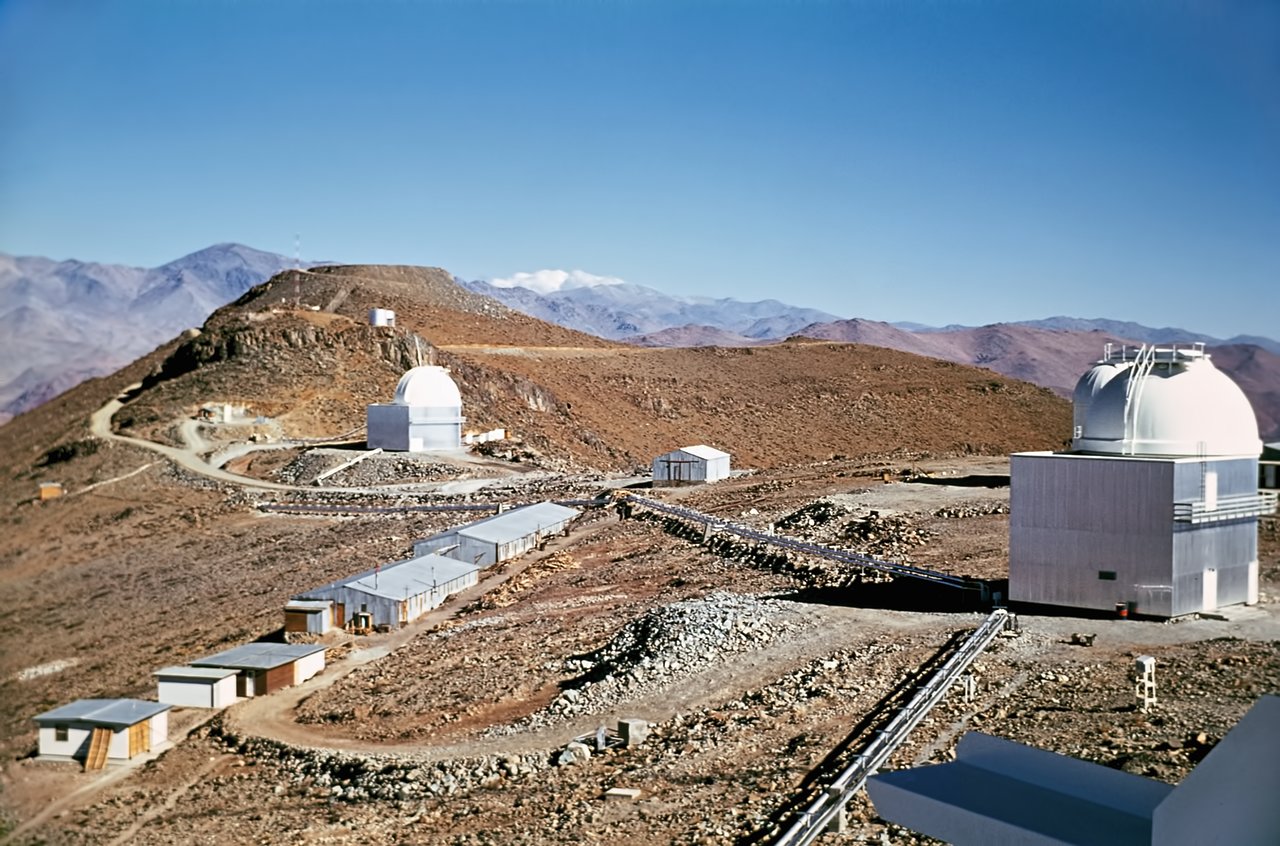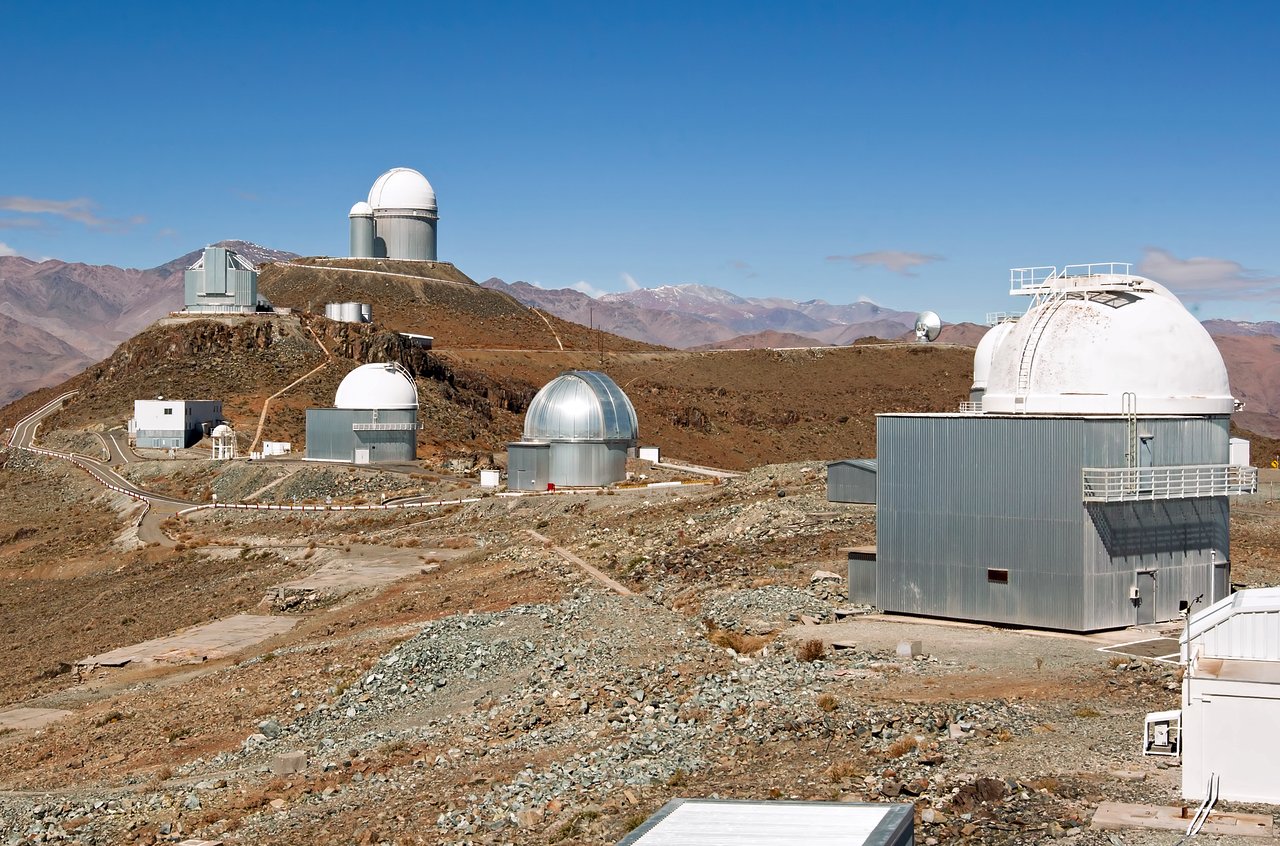A Glimpse into the Past — Then and Now at La Silla Observatory


ESO turns 50 this year, and to celebrate this important anniversary, we will be showing you glimpses into our history. Once a month throughout 2012, a special “then and now” comparison Picture of the Week will show how things have changed over the decades at the La Silla and Paranal observatory sites, the ESO offices in Santiago de Chile, and the Headquarters in Garching bei München, Germany.
Our first stop on this journey through time is at La Silla, the first of ESO’s observatory sites. The historical image was taken in the late 1960s or early 1970s from the dome of the ESO 1.52-metre telescope, which had its first light in 1968. A second photograph, taken in the present day, shows how much the observatory has changed over the decades. You can examine the changes with our mouseover image comparison.
In the historical image, we can see the ESO 1-metre telescope in the foreground on the right, with the Grand Prism Objectif telescope (GPO) just peeking out from behind. The third telescope in this photo is the Schmidt 1-metre telescope, on the left. Behind it, at a higher level, are the water tanks of the observatory.
Moving through time to the present-day, we can see how much La Silla has evolved, with many more telescopes on the site. The ESO 3.6-metre telescope and the adjacent Coudé Auxiliary Telescope now stand out on the highest peak. The angular enclosure of the New Technology Telescope (NTT) is just to the left, next to the water tanks. The 15-metre-diameter dish of the Swedish–ESO Submillimetre Telescope (SEST) watches the horizon on the far right.
The new photograph was taken from a slightly different position on top of the ESO 1.52-metre telescope building, so the GPO is now hidden behind the ESO 1-metre telescope in the foreground. The white dome that is just visible behind the 1-metre is the Danish 1.54-metre telescope. In the centre of the photo we now see the silvery dome of the MPG/ESO 2.2-metre telescope.
Although some telescopes at La Silla, such as the ESO 1-metre and 1.52-metre, and the SEST, are no longer in operation, others are still doing front-line astronomy. The ESO 3.6-metre telescope hosts the HARPS instrument, the world’s leading exoplanet hunter (see eso1134 for some recent results). The NTT has been used to help explain the formation of massive stars (see eso1029). Both telescopes provided vital data which led to the discovery of the accelerating expansion of the Universe — a discovery for which the 2011 Nobel Prize in Physics was awarded. The MPG/ESO 2.2-metre telescope has also produced a treasure trove of data from breathtaking wide-field images to studies of gamma-ray bursts, the most explosive events in the Universe.
Links
- The historical image
- The present-day image
- Side-by-side composite of the historical and present-day images
- More about La Silla
- Press release on the occasion of the 40th anniversary, in 2009, of La Silla’s inauguration
- ESO timeline
Kilde
ESO/J. Dommaget
Om billedsammenligningen
| Id: | potw1201a |
| Udgivelsesdato: | 3. januar 2012 15:00 |
Billeder
Our use of Cookies
We use cookies that are essential for accessing our websites and using our services. We also use cookies to analyse, measure and improve our websites’ performance, to enable content sharing via social media and to display media content hosted on third-party platforms.
ESO Cookies Policy
The European Organisation for Astronomical Research in the Southern Hemisphere (ESO) is the pre-eminent intergovernmental science and technology organisation in astronomy. It carries out an ambitious programme focused on the design, construction and operation of powerful ground-based observing facilities for astronomy.
This Cookies Policy is intended to provide clarity by outlining the cookies used on the ESO public websites, their functions, the options you have for controlling them, and the ways you can contact us for additional details.
What are cookies?
Cookies are small pieces of data stored on your device by websites you visit. They serve various purposes, such as remembering login credentials and preferences and enhance your browsing experience.
Categories of cookies we use
Essential cookies (always active): These cookies are strictly necessary for the proper functioning of our website. Without these cookies, the website cannot operate correctly, and certain services, such as logging in or accessing secure areas, may not be available; because they are essential for the website’s operation, they cannot be disabled.
Functional Cookies: These cookies enhance your browsing experience by enabling additional features and personalization, such as remembering your preferences and settings. While not strictly necessary for the website to function, they improve usability and convenience; these cookies are only placed if you provide your consent.
Analytics cookies: These cookies collect information about how visitors interact with our website, such as which pages are visited most often and how users navigate the site. This data helps us improve website performance, optimize content, and enhance the user experience; these cookies are only placed if you provide your consent. We use the following analytics cookies.
Matomo Cookies:
This website uses Matomo (formerly Piwik), an open source software which enables the statistical analysis of website visits. Matomo uses cookies (text files) which are saved on your computer and which allow us to analyze how you use our website. The website user information generated by the cookies will only be saved on the servers of our IT Department. We use this information to analyze www.eso.org visits and to prepare reports on website activities. These data will not be disclosed to third parties.
On behalf of ESO, Matomo will use this information for the purpose of evaluating your use of the website, compiling reports on website activity and providing other services relating to website activity and internet usage.
Matomo cookies settings:
Additional Third-party cookies on ESO websites: some of our pages display content from external providers, e.g. YouTube.
Such third-party services are outside of ESO control and may, at any time, change their terms of service, use of cookies, etc.
YouTube: Some videos on the ESO website are embedded from ESO’s official YouTube channel. We have enabled YouTube’s privacy-enhanced mode, meaning that no cookies are set unless the user actively clicks on the video to play it. Additionally, in this mode, YouTube does not store any personally identifiable cookie data for embedded video playbacks. For more details, please refer to YouTube’s embedding videos information page.
Cookies can also be classified based on the following elements.
Regarding the domain, there are:
- First-party cookies, set by the website you are currently visiting. They are stored by the same domain that you are browsing and are used to enhance your experience on that site;
- Third-party cookies, set by a domain other than the one you are currently visiting.
As for their duration, cookies can be:
- Browser-session cookies, which are deleted when the user closes the browser;
- Stored cookies, which stay on the user's device for a predetermined period of time.
How to manage cookies
Cookie settings: You can modify your cookie choices for the ESO webpages at any time by clicking on the link Cookie settings at the bottom of any page.
In your browser: If you wish to delete cookies or instruct your browser to delete or block cookies by default, please visit the help pages of your browser:
Please be aware that if you delete or decline cookies, certain functionalities of our website may be not be available and your browsing experience may be affected.
You can set most browsers to prevent any cookies being placed on your device, but you may then have to manually adjust some preferences every time you visit a site/page. And some services and functionalities may not work properly at all (e.g. profile logging-in, shop check out).
Updates to the ESO Cookies Policy
The ESO Cookies Policy may be subject to future updates, which will be made available on this page.
Additional information
For any queries related to cookies, please contact: pdprATesoDOTorg.
As ESO public webpages are managed by our Department of Communication, your questions will be dealt with the support of the said Department.

